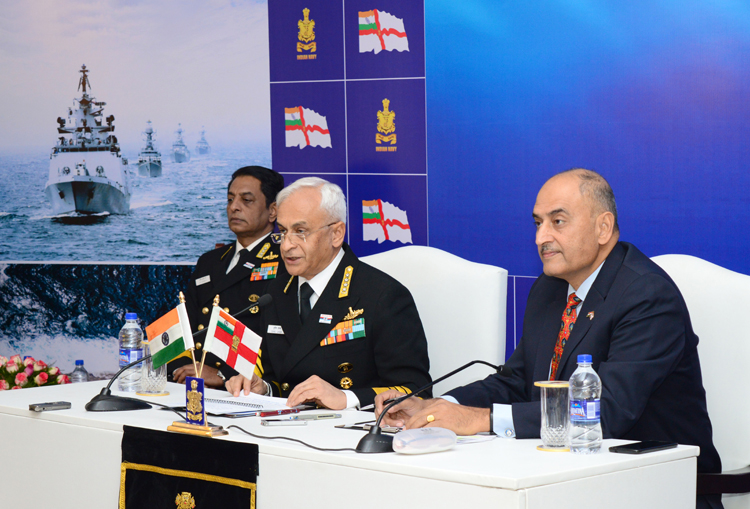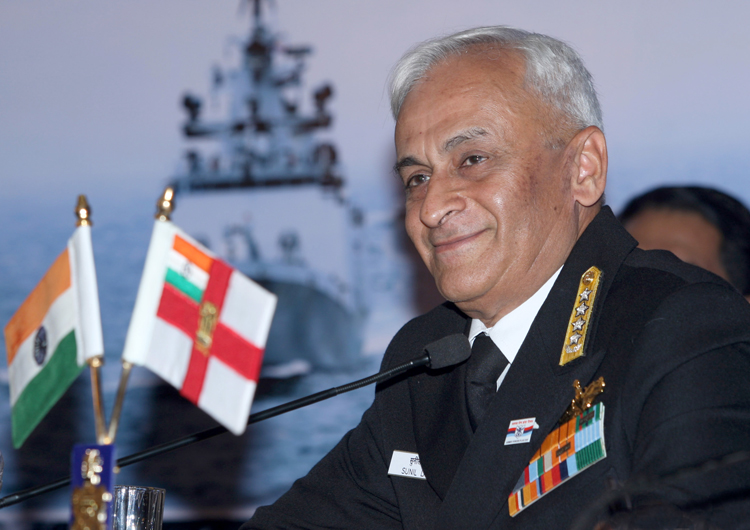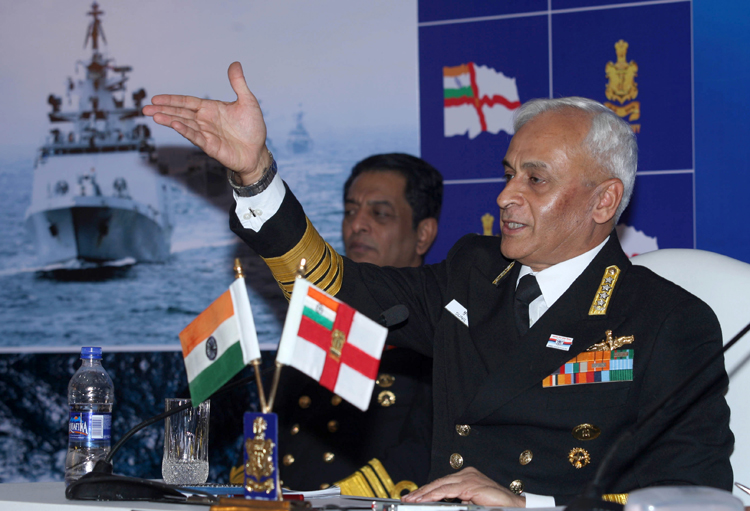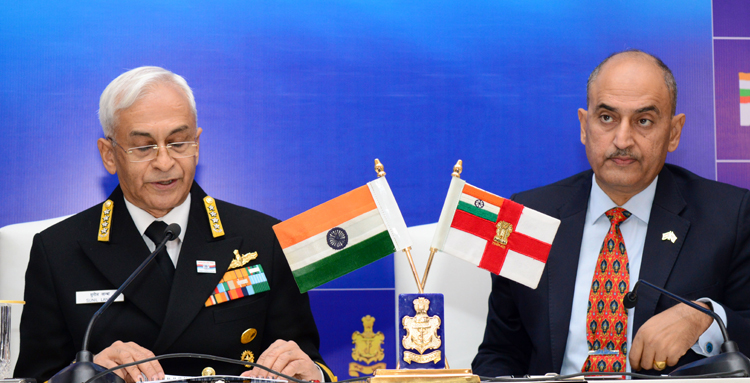Opening Remarks Navy Day Press Conference

Members of the Media Ladies and Gentlemen. It is indeed a pleasure and a privilege for me to welcome all of you to this year's Navy Week Media interaction.
We in the Navy, duly acknowledge your contribution towards shaping the maritime discourse in the country. We are also grateful to the media for having presented news, opinions and enlightened debates on naval matters through the years.
Before I begin, I would like to take this opportunity to remember our martyrs, Veer Naris and veterans for their service and sacrifices, as we rededicate ourselves to the service of the Nation. The Navy Day is celebrated to commemorate the success of Operation Trident, which saw Missile boats of the Indian Navy's Killer squadron, undertaking a blazing attack on Karachi harbour of 04 December 1971.
On this occasion, I would also like to remember one of our illustrious Flag Bearers, Vice Admiral Manohar Prahlad Awati, who passed away last month. He was the Commanding Officer of INS Kamorta and played a stellar role in the 1971 war for which he was awarded the Vir Chakra.
I intend to provide you with a broad overview of the Indian Navy's major operational activities over the past year. I will then highlight our plans for the future. Thereafter, the house will be open for questions.
As we surge ahead in the 21st century, the attention of the entire world is focused on the Indian Ocean Region, where our Navy is increasingly seen as a 'net security provider'. The maritime dimension of India's security and its importance to national development and economic prosperity is well recognised today, and has been articulated at the highest levels by our leadership. Accordingly, our maritime security strategy is aimed at providing a maritime environment that is free from all forms of traditional and non-traditional threats to our national development.

You are aware that the Indian Navy has successfully completed the first deterrence patrol of INS Arihant this year. With this, we have operationalised the third and the most survivable segment of the country's nuclear triad.
Last year we had undertaken a major review of our operational deployment philosophy and based on the prevalent security threats and challenges, we had recalibrated towards 'Mission Based Deployments' in our areas of maritime interests.
As regards our commitment to thwarting the bane of piracy in the Gulf of Aden, the Indian Navy remains steadfast and committed towards curbing this global menace. Since 2008, a total of 70 Indian Naval warships have been deployed, which have safely escorted more than 3440 (including 413 Indian flagged) ships with over 25,062 mariners embarked. I must also share with you that, so far, the Indian Navy has thwarted 44 piracy attempts and apprehended 120 pirates, a visible demonstration of our efforts towards guaranteeing safe and secure seas to mariners. As a matter of fact, just last month, one of our Mission deployed ships in the Gulf of Aden intercepted a suspected pirate vessel off the coast of Somalia and seized weapons and ammunition from it.
What we have been able to operationally achieve across this wide canvas of maritime theatre has been largely due to the combat skills honed during major exercises. This year, the Navy exercised its composite combat capability through an array of theatre-level exercises, both on the Western as well as Eastern seaboards. In addition, we also conducted a theatre-level Operational level war gaming exercise titled SHIKSHA-18 which also included proving of joint concepts with Indian Army and Air Force. Exercises like these allow us to refine the Navy's war plans, address Op Logistics issues and integrate the three Services in conduct of large-scale Joint Operations across multiple theatres.
On similar lines, we remain actively engaged with the Indian Coast Guard to maintain a sharp vigil over our vast coastline including over our island territories. Dedicated joint coastal security exercises such as Sagar Kavach and Avardhan have significantly augmented our collective surveillance efforts along the coastal areas.
I am glad to inform you that the Navy would be conducting its flagship Theatre Level Operational Readiness Exercise, TROPEX, from end January till early March next year. The exercise will see participation of all our operational ships, submarines and aircraft as well as units from the Indian Coast Guard. In addition, significant participation from the Indian Army and Air Force will truly enhance the integrated operations of the three Services.

As part of TROPEX, we would also be conducting a large-scale coastal defence exercise 'Exercise Sea Vigil' which will involve all stakeholders across mainland and island territories. We aim to test the robustness of our entire coastal security apparatus through his massive exercise.
In our quest for stable and tranquil maritime boundaries and to enhance interoperability as well as develop a common understanding of the region's security challenges, we actively participate in numerous regional maritime exercises with our partner nations. This year, the tempo of our overseas deployments and maritime exercises has been at an all-time high.
- The Indian Navy has participated in close to 20 exercises with friendly foreign countries this year.
- Our participation across a wide canvas ranging from Varuna off Reunion islands, Malabar off Guam, RIMPAC at Hawaii, Kakadu at Darwin, WPNS cum IFR at Jeju, Republic of Korea, IBSAMAR off Simons Town, South Africa, SLINEX off Trincomalee and the very recent 25th edition of SIMBEX off Port Blair and Vizag have helped us further enhance our collaborative efforts with the navies of the Indian Ocean Region and beyond.
- Under the Government of India's overall rubric of 'Neighbourhood First' policy, the Indian Navy also undertook Joint EEZ patrols of Maldives, Seychelles and Mauritius, as well as Coordinated Patrols (CORPATs) with Myanmar, Thailand and Indonesia.
- Maiden Bilateral Exercises with UAE and Indonesia and maiden CORPAT with Bangladesh were also commenced this year.
- We are also on the cusp of commencing bilateral exercises with Bangladesh and Malaysia, next year.
These activities help enhance interoperability and ensure security in our maritime neighbourhood as well as in the 'Global Commons'.
In addition to honing our combat skills and forging closer ties with our maritime neighbours and partners, we continue to be at the forefront of Humanitarian Assistance and Disaster Relief efforts. The devastating impact of Climate Change is serious cause of concern and this year, several regions in the country witnessed severe natural calamities.
- The floods in Kerala was an unprecedented occurrence of its kind and the Navy conducted Operation Madad for over two weeks, rescuing over 16,843 people and followed-it up with elaborate relief and rehabilitation efforts.
- Large-scale rescue efforts during Cyclone Titli that hit our East Coast also saw our personnel and assets coming together to provide succour to those in need.
- The Navy also rendered assistance in our maritime neighbourhood during times of natural disasters. This year, we deployed our assets to undertake relief missions in Bangladesh, Indonesia, Sri Lanka and Mauritius as part of these efforts.
- I would like to assure our countrymen that the Indian Navy remains committed and ready to provide succour and relief in any part of the nation as well as in the Indo-Pacific Region.
I am pleased to share with you that the Indian Navy's initiatives such as the Indian Ocean Naval Symposium – IONS; MILAN – the biennial gathering of regional navies at Port Blair and Goa Maritime Conclave, have enabled constructive dialogue amongst navies of the Indian Ocean Region.
IONS has taken shape as the premier maritime forum of the IOR with several constructive initiatives achieving realisation through collaborative efforts. Last year, while Bangladesh Navy was the Chair of IONS, the forum made its first move towards greater operational engagement through the conduct of International Maritime Search and Rescue Exercise or IMMSAREX, as its first ever operational exercise.
- This year, IONS achieved a major milestone through formulation of guidelines for HADR in IOR and conduct of a maiden table-top exercise at Visakhapatnam.
- This year also marks 10 years of IONS and to mark this event, the Indian Navy recently hosted commemorative events in last month at Kochi, that included a seminar with the theme 'IONS as a catalyst for Security and Growth for all in the Region (SAGAR)' and a Tall Ship Sail Together from Kochi to Muscat, alongwith Sea Riders from several IONS member states.
- I am confident that with every passing year, this forum will gain even more traction and realise its true potential.
Earlier this year, the Indian Navy hosted the 10th edition of Milan at Port Blair, with a multilateral Milan Exercise Sea (MILES) which saw participation of 20 ships including 11 foreign Naval ships making it the largest multilateral exercise to be conducted in the Andaman Sea.
The Goa Maritime Conclave, which we commenced in 2017 with an aim to provide a dedicated apex-level forum for interactions between like-minded maritime nations of South and South Eastern IOR has gained wide acceptance. This conclave helps in promoting the spirit of cooperative solutions to contemporary maritime security challenges. We intend to hold this event once every two years with the next edition, planned in 2019.

Information sharing among countries to enhance maritime domain awareness at the regional level has been accorded renewed impetus at the highest levels. We have signed White Shipping Information Exchange agreements with nineteen countries and operationalised them with twelve countries. The Information Management and Analysis Centre (IMAC) of the Indian Navy has also emerged as a virtual information hub for White Shipping Information in the region. We are also in the process of setting-up an Information Fusion Centre (IFC-IOR) to further our commitment towards achieving collective maritime security in the IOR.
I will now move from operations to force level planning and future acquisition plans.
Inductions of new assets and capabilities are being progressed in consonance with the Indian Navy's long-term perspective plans. Before I come to the specifics of the projects, I will briefly update you on our thrust towards supporting the 'Make-in-India' vision.
- Since 2014, 82 % of AoNs on cost basis have been accorded to Indian Vendors.
- During the same period, 72% of the cost of contracts concluded are with Indian Vendors.
- Further, more than two-third of the Navy's modernisation budget has been spent on indigenous procurement in the last four financial years.
- Nearly 60% of the naval budget is earmarked for modernisation and capital expenditure. This healthy ratio is achieved through careful control of revenue expenditure and stretching every rupee to the maximum.
Indian Navy has also been at the forefront of 'Self Reliance in Defence Production', right since Independence. As I speak today, 32 ships and submarines are presently under construction in Indian shipyards. These include the Aircraft Carrier, Vikrant, P-15B Class Destroyers, P17A class stealth Frigates, P28 ASW Corvettes, Offshore Patrol Vessels and Scorpene class submarines. In addition, Govt approval has also been accorded for 56 Ships and six submarines.
The Indigenous Aircraft Carrier is presently in its third and final Phase of construction at Kochi. The Sea trials for the ship are expected to commence mid 2020 and we are closely working with all stakeholders to achieve the delivery timelines. Induction of Vikrant will provide significant fillip to the Navy's blue water capability, increasing the reach and impact of Carrier borne strike forces, both as a means of deterrence as well as during combat operations.
The Carrier's substantial integral air power with rapid mobility would be a force multiplier giving India enhanced combat power to protect its maritime interests and Sea Lines of Communication. To achieve this, we should have the capability of operating two Carrier Battle Groups round the year.
- The case for the second Indigenous Aircraft Carrier has received the necessary impetus. Though it is atleast a decade away, the Aircraft Carrier project would accrue signficant national gains in terms of boosting indigenisation and the country's economy, through its life cycle of construction, maintenance and upgradation.
- We are looking at ways and means to incorporate the immense potential of Academia, private industry and DRDO into the Project.
- Spread over period of ten years, the expenditure would not only be feasible, but would also be ploughed back into our own economy.
- We are also hopeful that naval version of LCA produced by HAL would fly from its deck.
Modernisation of the submarine arm is also well underway. The second Scropene Class submarine Khanderi has completed her major trials and is expected to be ready for commissioning shortly. The third and fourth submarines of this project namely Karanj and Vela are also undergoing various stages of pre-induction trials.
On the aviation front, a long standing critical shortfall in the naval helicopter fleet has been finally addressed with the accord of AoN for 111 Utility Helicopters in August this year And issue of LOR (Letter of Request) for 24 Multi Role Helicopters last month. We are working at timely realisation of these projects.
This year also saw the Navy acquiring another significant capability, placing us in a select league of navies capable of providing Submarine Search and Rescue in the Indian Ocean Region. Induction of the 1st Deep Submergence Rescue Vehicle (DSRV) system is scheduled at Mumbai this month followed by operationalisation of the 2nd DSRV system at Visakhapatnam by Mar next year.
The year gone by has seen a positive upswing towards contract conclusion in major shipbuilding projects, the salient ones being for procurement of two Diving Support Vessels with M/s HSL, Vizag, two follow-on ships of 1135.6 project to be constructed at Russia and four Survey Vessels (Large) with M/s GRSE, Kolkata. We are also targeting contract conclusion of 1135.6 (ex- GSL) and ASW-Shallow Water Craft in this financial year.
We hope that in the coming months, our projects related to LPDs, Fleet Support Ships and Mine Counter Measure Vessels will also move forward.
The operationalisation of Strategic Partnership Model, has happened with the accord of AoN for building 111 Utility Helicopters in India, which I mentioned a while earlier. This will be further consolidated with the release of Submarine specific guidelines for building P 75 (I) submarine indigenously, shortly. These projects will result in acquisition of knowhow and enable design and manufacture of major platforms such as submarines and helicopters in India, thereby enhancing the indigenous defence industrial capability in the Private Sector.
As regards infrastructure growth, Phase IIA of Project Seabird at Karwar is progressing well.
- Creation of a full-fledged Naval Dockyard and associated infrastructure to accommodate more number of ships, submarines and yard-craft is being undertaken during this phase
- We are also focused on developing island infrastructure. NAS Shibpur at A&N is scheduled to be formally commissioned as INS Kohassa in January 2019. This would provide enhanced connectivity to Northern Andaman Group of Islands as also increase surveillance capability in the region.
Ladies and gentlemen, while our focus remains on Induction of new technology and state-of-the-art platforms, the Indian Navy truly believes that professional skill and motivation of our personnel forms the heart and soul of our naval capability. Our well-trained, highly motivated and deeply committed human capital will always remain our greatest asset. We are constantly at work to keep our HR polices in sync with the nations' aspirations and expectations.
Training, remains one of the Navy's key focus areas. Here, I would like to share with you, that in addition to the wide spectrum of specialist training undertaken in-house at our world-class training institutes, we are also a favoured destination for many of our friendly foreign countries. Based on requests being received, we have increased the number of training vacancies for foreign trainees over the past few years from 699 to 1056.
We have also taken the lead as regards Joint Training recommendations of the Shekatkar Committee. The recent commencement of training for 68 Indian Air Force personnel on catering at INS Hamla as the Joint Service Training Insitution (JSTI), marks yet another important step in the Navy's endeavour to strengthen jointmanship as also re-balance defence expenditure through optimally harnessing the existing base of training resources.
Moving on, apart from excelling in all operational taskings across the wide canvas of Indo-Pacific this year, our men and women have also excelled in setting shining examples for the youth of the country to emulate.
- I am sure, you all would agree that our Lady Officers created history by successfully undertaking an arduous mission of sailing around the world, on the indigenously built sailing vessel. What added sparkle to this feat was that the boat that they embarked upon, Tarini, was Made in India!
- On similar lines, during the Asian and Commonwealth Games held earlier this year, our sports personnel have performed extremely well. We are now focused on providing them the very best of coaching and facilities for the 2020 Olympics.
This year also marks the Golden Jubilee of the Western Naval Command. Since its inception in Dec 1968, the Command has held the mantle of the entire Western theatre of maritime operations excelling in several operational campaigns .including the historic bombings on Karachi harbour on 04 Dec 1971. To commemorate the Golden Jubilee, a series of commemorative actives are planned at Mumbai in the coming weeks.
Ladies and Gentlemen, in keeping with this year's Navy Week theme which is 'Mission Deployed and Combat Ready', I would like to assure the nation that the Indian Navy continues to remain 'on watch' 24 X 7 safeguarding our national interests in the maritime domain.
On behalf of all uniformed and civilian personnel of the Indian Navy, I take this opportunity to convey my best wishes to our countrymen on the occasion of Navy Day.
Jai Hind. Sam no Varunah.





